Gulasz wolowy (or Polish beef goulash) is a dish that everyone should try at least once in a lifetime as nothing really compares to it.
Beef goulash has been a popular specialty in Central and Eastern European cuisines for centuries. It is a hearty stew made with beef, onions, and paprika.
The goulash in this recipe is cooked the traditional way, which has been enjoyed for generations. It contains no flour, and it’s cooked very slowly, sometimes even for more than six hours. But the taste of it is completely incomparable to any other variation of gulasz wolowy (or beef goulash).
What is gulasz wolowy or beef goulash?
The origins of gulasz wolowy or beef goulash are traced long into the history of Eastern Europe.
Originally from medieval Hungary, where it used to be a dish of the herdsmen “gulyas” (from which goulash inherited its name), the famous stew later spread into North, Central and Eastern European cooking pots and slowly became a very famous dish all over the world.
The stories reveal that the shepherds in the ninth century, before moving forward with their animals, prepared a stock of food made from slowly cooked pieces of meat, onions and spices. When the liquid of a cooked stew was absorbed, the dish was dried in the sun for the shepherds to be able to carry it in sheep’s stomach bags. When the herdsmen feasted again, the addition of water to the dried dish transformed it once more into a tasty goulash or beef soup.
It was only later, in the 16th century, when paprika arrived from the Ottoman Empire to these places and was added to the famous stew.
There’s an old saying that there are as many goulashes as there are cooks in the world. Which is probably true. Still, a goulash is certainly not every beef stew with onions and paprika. It’s a lot more than that.
The real, authentic gulasz wolowy can be quite tricky to cook. And it takes time. A lot of time. The more time you give to it, the better it will get.

Why you’ll love gulasz wolowy (Polish beef goulash)
- The traditional goulash is somehow a very special dish. In Europe, goulash is often cooked in large quantities for special occasions, like celebrations of public holidays and meetings in nature; many times, it’s served in mountain lodges.
- This outstanding dish is almost like it has a soul, bringing back the long-lost spirit of the herdsmen and their (holy) connection to nature. Cooking a goulash is a very personal thing. Even today, more times than not, it’s cooked by men rather than women. That’s a rare moment in time when men bring out their cast iron cauldrons and show us some magic 🙂
- It will feed crowds. A big pot of goulash combined with good homemade bread, dumplings, polenta, pie or even pasta will feed fifty people like no other food out there. In fact, you don’t even need to serve anything else than homemade bread with it; the unique taste of slow-cooked beef and onions will absolutely satisfy everyone invited. For example, it pairs perfectly with buckwheat bread with walnuts or polenta bread.
- When you prepare it in advance, the goulash will taste even better the next day. After cooling and reheating again, the onions in the goulash will completely dissolve and become absorbed by the beef, leaving you with a miraculously outstanding dish to enjoy. Remember, that’s how and why goulash was invented in the first place, to be prepared and stored for the coming days in advance.
- Because of the time it takes to cook, it makes no sense to cook goulash in small quantities. For the goulash, you’ll probably use a giant pot, or it might even motivate you to buy a bigger one. The large amount of onions in the traditional recipe will prevent the goulash from getting spoiled as quickly as any other stew. Packed in smaller containers and frozen, this incredible food will make you smile and blink whenever you don’t have time but need to pull out something authentic and special.
- Besides ričet, kljukuša and sataraš, authentic beef goulash is one of the best Slavic food recipes.

Ingredients you’ll need
BEEF -Beef represents half of the ingredients for a good gulasz wolowy (beef goulash), while the other half consists of onions.
The meat doesn’t need to be from the most expensive beef cuts; the goulash will turn out the best when the meat is chosen from different beef cuts. While it’s easier to cut the softer parts, on the other hand, collagen tissues from other parts will dissolve in the onion sauce and make the goulash juicier and thicker.
ONIONS – Onions are the next crucial ingredient. Authentic goulash contains no other additional ingredients except beef, onions and paprika. It will be the onions that will dissolve and become partially absorbed by the beef, which will ensure the goulash becomes sweet and addictively delicious.
The taste of a goulash made this way is completely different from the beef stew thickened with flour or mashed potatoes that you’ll find in many recipes.
A fundamental rule for cooking a good goulash is to use the same amount of beef and the same amount of onions. And it’s somewhat true that the larger the amount of both ingredients you’re cooking, the better it will taste.

PAPRIKA – You might very well have already figured out that it does matter what kind of paprika you add to the goulash. That’s why it’s quite important to buy quality paprika (as fresh as possible) or Hungarian paprika instead of the cheap packages you’ll find in many markets.
Paprika will add a warm flavor to the goulash and quite the opposite of what you may think; the mixture of the beef, onions and paprika will not stay red-colored but turn into a nice dark brown color and juicy texture.
An excellent way to enhance the paprika flavor in the goulash is to add three or four halves of red bell peppers into the stew while cooking. When the peppers eventually soften, you’ll remove just the skin and let the rest dissolve into the goulash.
BAY LEAVES & MARJORAM – People sometimes think that there are some very special spices in the goulash. However, the best goulash recipe doesn’t call for anything except bay leaves and marjoram.
It’s the beef and the onions that make the sweet and extraordinary taste of the goulash. Even if paprika is reduced or completely excluded, the goulash will still taste great.
We used two dried bay leaves for a kg (2 lbs) of beef, which is enough to add a gentle flavor layer to the goulash. If too many bay leaves are added, it will make the dish taste bitter.
Only a teaspoon of marjoram will add warmth and sharpness to the flavor.
RED WINE – A glass of red wine will help enhance other ingredients’ natural aroma. Adding alcohol to the stew helps release the ingredients’ flavor and dissolve the fats in the beef. The alcohol will completely evaporate while cooking, but the final result will be the goulash’s concentrated and enhanced aroma.
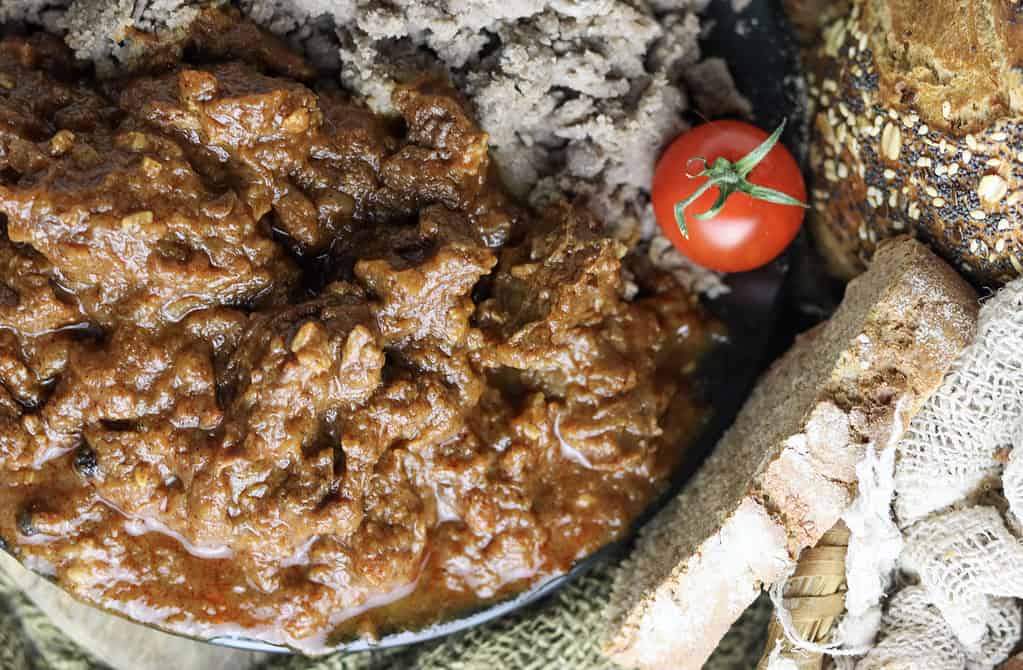
GARLIC – If cooking the goulash from a kilo (2 lbs) of beef, five cloves of garlic will be enough. If you’re a garlic addict, you can add more, it won’t spoil the delicious sauce. However, a large amount of onions in the goulash creates the stew’s specific flavor.
SALT & PEPPER – As mentioned, an authentic goulash doesn’t need any additional spices to taste delicious. You need no stock powder or additional premade all-purpose seasonings. The best goulash aroma is created by slowly cooking the simple ingredients in it. Adding anything more than salt and black pepper (both powdered and whole) is undesired and unnecessary.
OIL – We used olive oil in this recipe for sauteeing the onions. Nevertheless, originally, lard was used when cooking authentic goulash.
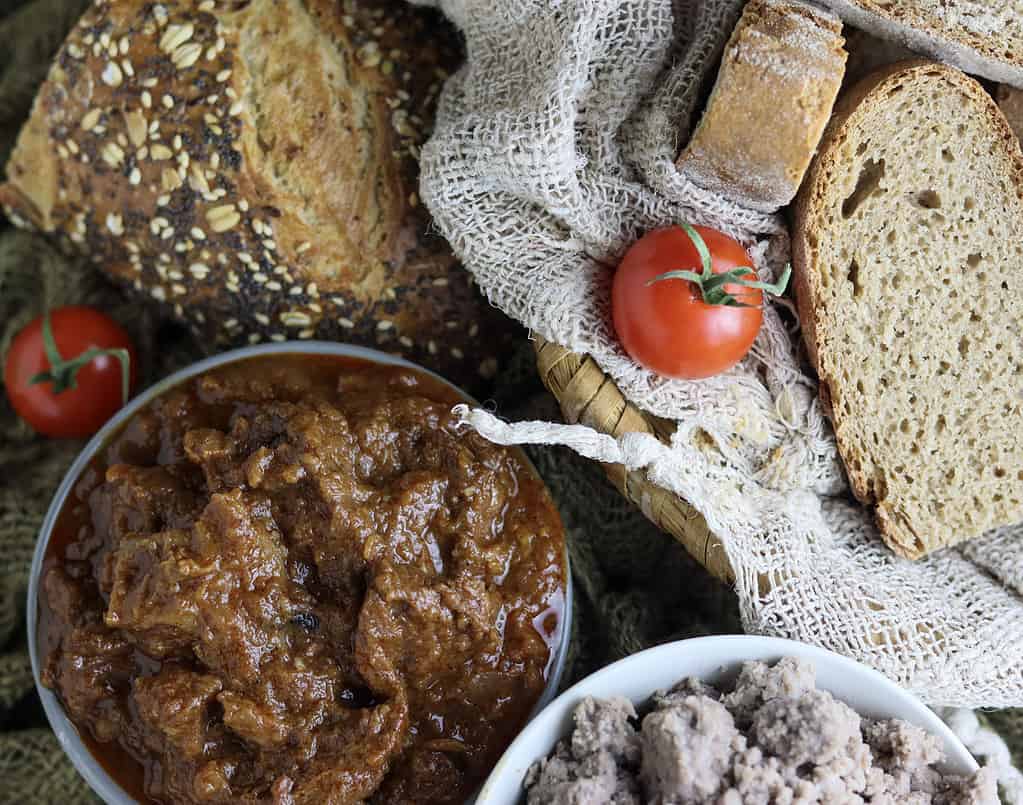
How to make gulasz wolowy (beef goulash)?
COOK THE ONIONS FIRST
STEP 1: Cut the beef into larger chunks, about 2 cm or 0.8 inch wide. Let it rest in the refrigerator while you cut the onions.

STEP 2: Peel and cut the onions into pieces as small as possible. If you’re cooking gulasz wolowy with 2 lbs of beef, that’s exactly how many onions you need.
Dicing all the onions into small pieces might last a long time, but we don’t recommend using a food processor instead. Besides that, try to ensure that the onions are cut as fresh as possible before getting fried.
To avoid crying while cutting the onions, place them in the refrigerator or cold water for half an hour before working with them.


At the same time, you can also peel and crush the garlic. Most of the time, we use a simple garlic crusher, which really makes the job much easier and faster.
STEP 3: Heat the oil (or lard) in a cooking pot and fry the onions till they get soft and translucent. Add salt to the onions and stir often to ensure the onions don’t get burned.
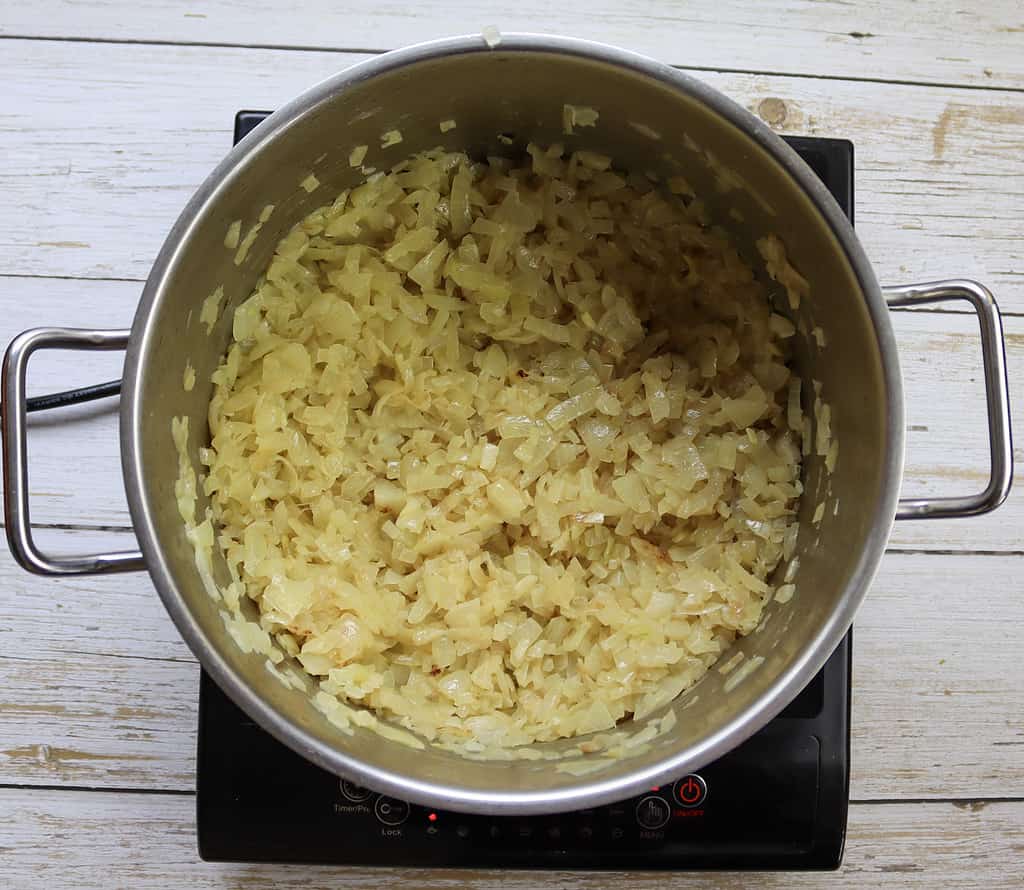
STEP 4: Add the paprika, garlic, black pepper and bay leaves to the pot. Stir for a minute, then pour in a cup of red wine and keep cooking the onions for at least another hour on low heat until they soften and start resolving.

If the onions get too dry, keep adding water to the pot to keep them covered.
Do not shorten or skip this step; if you add the beef to the pot too early, the onions will not dissolve, and the goulash sauce won’t be juicy and thickened as desired.

COOK THE GOULASH
STEP 5: Finally, when the onions are cooked and softened enough, add the meat to the pot. Stir to fry the meat a little bit, then add water to cover the ingredients.
Cover the pot with a lid and slowly simmer on very low heat until the meat softens, at least for another two or three hours.
The best goulash is made when it’s cooked extremely slowly, on low heat for a very long time. Some cooks simmer the goulash for six whole hours or even more.

What’s important at this step is that the ingredients aren’t boiling to the fullest but that they cook nice and slowly.
The longer the goulash is cooked, the tastier it will get. The onions will get absorbed by the beef, and what you’ll get is a tasty dish that you can’t even compare to any other stew.
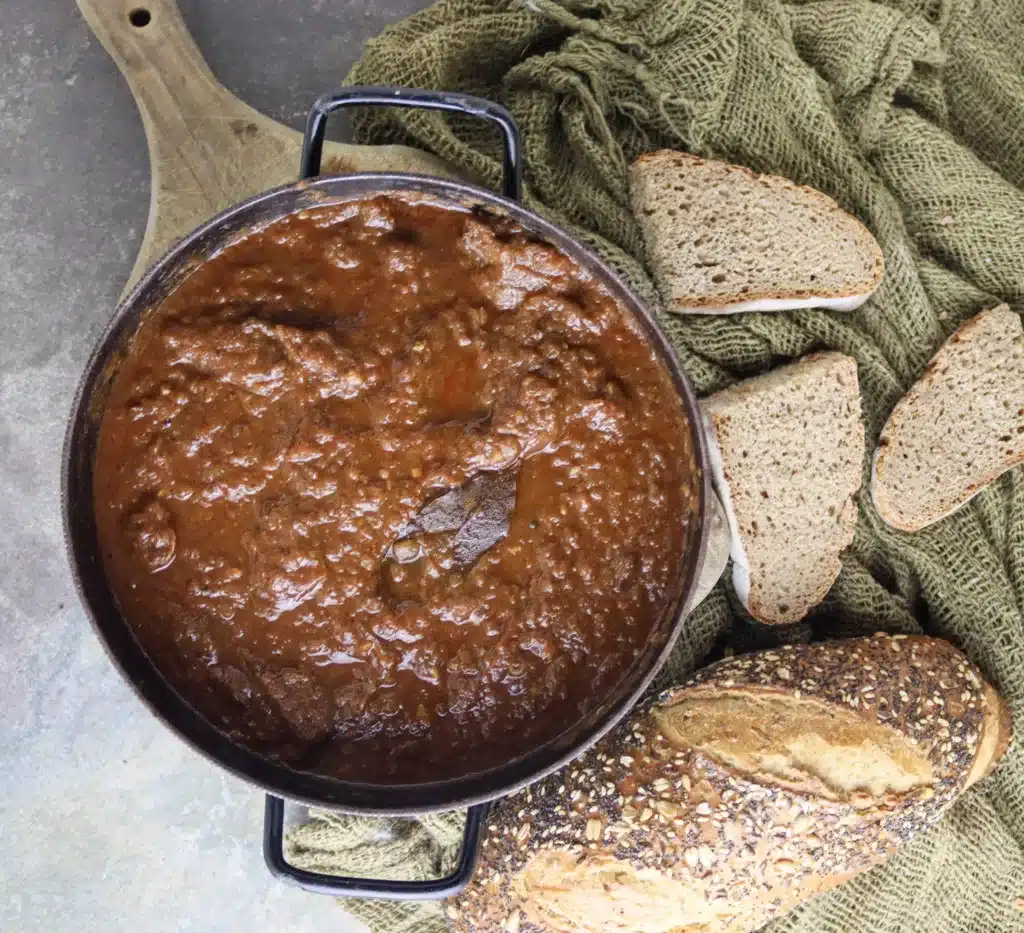
And do not worry if the sauce gets too thick. Any time you add some water, you can get a sauce that is thinner, but at the same time, it won’t lose the delicious taste and deep flavor like other stews when they are too liquid.
Gulasz wolowy tips to remember
- When buying beef, make sure the meat is as fresh as possible. The taste partially depends on what cuts of beef you will use, but the best goulash will be cooked from mixed parts and not only one.
- Taking the time and cooking gulazs wolowy slowly and long enough is the most important thing to make a really delicious and authentic stew.
- Make sure that the powdered paprika is as fresh as possible. Adding a few large pieces of fresh red bell peppers and removing the skin when cooked will enhance the deepness of the sauce.
- To get a deep and really rich taste of gulasz wolowy, cut the onions right before cooking; otherwise, the onions will oxidize on fresh air, which will change the sauce taste. The smaller the pieces of the onions are, the easier they will dissolve and become absorbed by the beef.
- Avoid using a food processor to cut the onions. If the tears while cutting the onions bother you, place the onions before cutting in the refrigerator or cold water before working with them.
- Frying and softening the onions will be accelerated if you add salt right in the beginning. Do not fry the onions too quickly or on too much heat. The onions should not get browned; they should only get a nice yellow color while softened and translucent.
- When adding paprika to the onions, stir only for a minute or even less, then quickly add the wine and/or water. If the paprika is fried dry, it might get somewhat bitter.
- Cook the onions for at least one hour, preferably even more, to get the onions thoroughly soft and at least partially dissolved before adding the meat.
- If you cook the gulasz together with the beef for too long, the meat will get too soft and will start falling apart. Contrary to that, if you don’t cook it long enough, the onions won’t completely dissolve, and the sauce won’t be as juicy and delicious as it should be. The art of making a good gulasz wolowy or beef goulash consists of catching just the right time when to add the meat and cooking it very slowly.
- When adding the beef to the onions, cook the goulash covered with a lid on very low heat for another two to three hours or more until the beef softens enough. Some of the best goulashes are sometimes cooked even for six hours. Stir occasionally when needed. If the gulasz gets too thick, keep adding glasses of water so that the ingredients are covered with water all the time, but no more than that.
- When the onions and the collagen in the tissues get dissolved, they will be absorbed by the beef. Do not worry if the sauce gets too thick; you can always thin it with water, which will not make the sauce watery, less juicy or less tasty as that happens with other stews.
- The authentic goulash will taste absolutely the finest when cooked over an open fire in a cast iron cauldron.
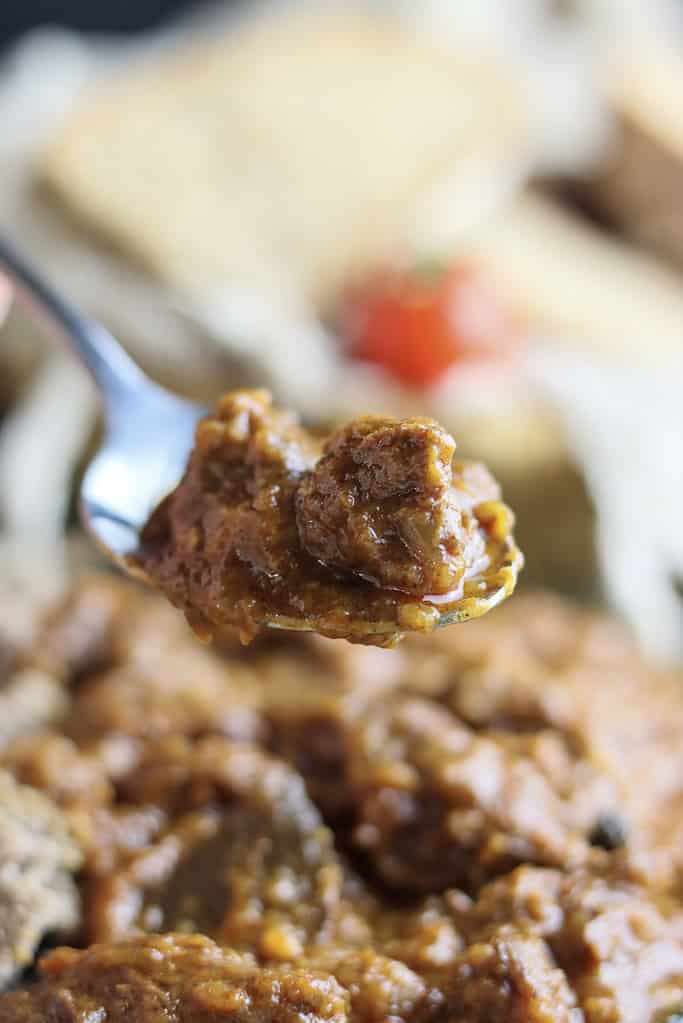
Storage and reheating
As you can see, the process of cooking gulazs wolowy or beef goulash is very slow. Besides that, the goulash is a perfect dish to keep stored; you can add it to other sauces, you can make soup out of it, or simply use it when you need something delicious but don’t have time to cook. That’s why people prefer to cook a rather huge cauldron of gulasz instead of small portions.
Remember, because of the large amount of onions, the goulash will taste even better if prepared in advance and reheated the next day.
When the gulasz wolowy cools down to room temperature, store it in an airtight container or a covered pot in the refrigerator for up to three days.
It can be stored frozen in an airtight container for up to three months.
Another very useful way of storing the goulash is following a simple canning process. Load the hot gulazs wolowy in hot, sterilized jars, close the jars with the lid, leave them to cool down under a blanket and store in a dark and dry place for up to six months.
I mean, is there anything more motivating than arriving in your favorite mountain shelter with a jar of homemade goulash and buckwheat bread in your backpack?

Gulasz wolowy (beef goulash) FAQs
The goulash needs to be simmered slowly on low heat for the fats and the tissues in the meat to dissolve. If you cook your goulash too quickly and at high temperatures, the meat will remain sturdy and tough. What helps in the cooking process for the meat to become softer is adding a glass of wine to the goulash.
A goulash needs to be cooked slowly for a long time for the onions and collagen tissues of the meat to dissolve, which will create a juicy and thick sauce. You can thicken the goulash with a spoonful of flour, but the sauce will absolutely taste much better if you cook it long enough that the onions themselves make it thicker.
The goulash will taste bitter if you add too much tomato sauce (which is not needed for the authentic goulash recipe), if you over-fried the onions or if you fry the paprika added to the onions for too long. When you add the paprika, fry it only for a minute or less, and immediately pour in the wine or water (or both).
Beef stew recipes many times contain added vegetables and potatoes and use flour or mashed potatoes for thickening the sauce. An authentic goulash consists of the same amount of meat and onions with added paprika. It’s cooked much slower and longer than the usual stews.
Yes, the authentic goulash recipe contains no flour or starchy ingredients; it’s made of meat, a large number of onions and paprika.
The Hungarian goulash can sometimes be made thin, almost as a soup, while the Polish goulash is a lot thicker.
The written sources of the original goulash are traced back to Hungarian herdsmen in the 9th century. The shepherds prepared a thick and sun-dried dish with meat and onions, which was carried in dried sheep’s stomachs to feast on their stopovers.
What is called a goulash by American recipes is basically pasta with meat stew. The original goulash recipe and the whole process of cooking the goulash differ significantly from the pasta meat sauce recipe in America.
More Slavic food recipes
Gulazs wolowy (Polish goulash)
INGREDIENTS
- 2 lbs quality beef meat (1 kg)
- 2 lbs onions (1 kg)
- lard or oil
- 1 cup red wine
- 1/5 cup fresh dried paprika (20 g)
- 5 cloves of garlic
- 2 dried bay leaves
- half teaspoon marjoram
- salt
- black pepper (powdered and whole)
- oil or lard
INSTRUCTIONS
- Cut the beef into large chunks (0,8 inch/2 cm)
- Peel and chop the onions to pieces as small as possible ans crush the garlic.
- Fry the onions on hot lard or oil until they soften and start looking nicely yellow. Imediately add a pinch of salt and be careful not to burn or over-fry them. Add the paprika, spices and the rest of the salt. Stir for a moment then pour into the pot a cup of wine and/or water. Cover with the lid and cook slowly on low heat for at least an hour until the onions soften and start dissolving. Stir frequently and keep adding small amounts of water if needed.
- When the onions are softened, add the beef. Stir and pour in another glass of water, so that the ingredients are covered. Simmer the goulash covered with a lid, very slowly on a very low heat for at least another two to three hours (preferably more). Stir occasionaly and add more water if needed.
- The goulash is done when the meat softens and the onions, fat and other tissues are completely dissolved in a juicy, thickening, delicious sauce and absorbed by the beef.
Video
NOTES
- The goulash will definitely turn out the most delicious if cooked in a cast iron cauldron over an open fire.
- The best goulash will be made of different fresh beef cuts and fresh, dried paprika of good quality.
- Adding a few halves of fresh red bell peppers (and removing the skin when cooked) will deepen the taste of the sauce to perfection.
- The authentic beef goulash recipe does not include any flour for thickening the sauce but the same amount of onions and meat. The magic lies in the process; cooking the goulash slowly and very long on very low heat will result in a juicy, delicious taste of beef and thick sauce.
- Prefer chopping the onions to pieces small as possible rather than using a food processor. Add a pinch of salt immediately when you start frying them.
- When adding the paprika, do not fry it for long, as it might contribute to a bitter taste of the goulash. Pour a glass of wine and/or water over the paprika and saute.
- The onions, together with paprika and spices, should be cooked for at least an hour before adding the beef.
- It’s important to catch the right time when adding the beef. The meat should cook very slowly on low heat for at least two to three hours to get a delicious goulash, preferably even more. If the heat is too high or the meat is cooked for too long, it will start falling apart. It takes practice to cook a perfect goulash.
- When the onions and the collagen in the tissues get dissolved, they will be absorbed by the beef. Do not worry if the sauce gets too thick, you can always thin it with water, which will not make the sauce watery, less juicy or less tasty as that often happens with other stews.
- Because of the slow cooking process, prefer to cook a larger amount of goulash that can be easily stored.
- Store your gulasz wolowy in an airtight container or a covered pot in the refrigerator for up to three days. The goulash will taste even better when reheated the next day.
- Frozen goulash can be stored in the freezer for up to three months.
- Following a simple canning process, you can store your goulash in jars in a dark and dry place for a few months.
- The stored goulash can be used as a perfectly tasty dish whenever you don’t have the time to cook. It can be added to enrich other sauces and stews or even transformed into a tasty beef soup.
Nutrition
If you tried our gulasz wolowy (beef goulash) recipe, please rate it in the comments below.
Show your love by sharing ❤️



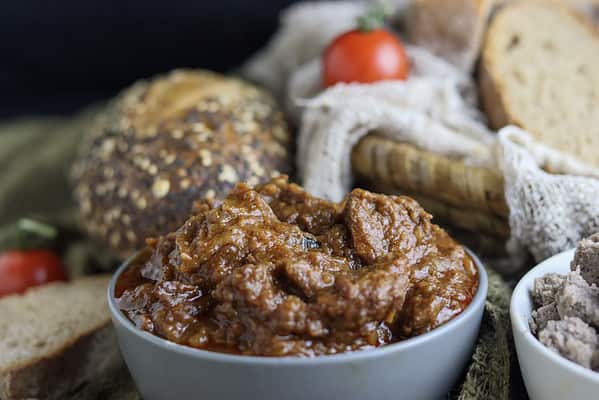
Delicious! Thank you, pinned.
Thanks Melynda; it’s definitely worth a try.
Thanks for sharing at the What’s for Dinner party – hope your week has been going great!
Thanks Helen; it’s an absolute pleasure to see what’s for dinner around the world.
The last time I had beef goulash was in Germany just back in January this year. It was delicious 😋.
Maybe some day I’ll try to make it myself following your recipe.
Indeed, authentic goulash is an old, traditional dish, very delicious and very specific. It that was originally cooked by the herdsmen. So even today, it happens very often in Europe that men are actually cooking the goulash. So I suggest you inform your hubby about it; find him a nice, big cauldron, sit back, chill and enjoy the process 🙂
I love goulash and this looks the real deal. I wish someone would invent lick-a-vision!
Thank you Sammie; you’re invited!
Well…I learned a ton of interesting information here. I’d heard of goulash, but kind of thought it was a rice and meat and tomato dish.
Thanks for sharing your post at the Sunday Sunshine Blog Hop 76!
Laurie
I can imagine, American goulash and the one cooked in Eastern Europe are basically two completely different dishes. I really hope you’ll try it, and please let us know how it worked out.